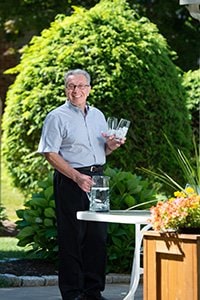Dry Needling
Right On Target
 Tom Capuzziello had been in nearly unbearable pain for two years, and was desperate for relief. The pain was in his groin area, and had become so severe he was unable to pick up his right leg, go up stairs or walk for any distance. While Tom had been diagnosed with sacroiliac joint dysfunction and hip osteoarthritis, a series of advanced tests were unable to figure out exactly what was causing his severe leg pain. He tried every treatment offered to him, ranging from shots in his back to exercises prescribed by a physical therapist, but nothing was able to alleviate his pain.
Tom Capuzziello had been in nearly unbearable pain for two years, and was desperate for relief. The pain was in his groin area, and had become so severe he was unable to pick up his right leg, go up stairs or walk for any distance. While Tom had been diagnosed with sacroiliac joint dysfunction and hip osteoarthritis, a series of advanced tests were unable to figure out exactly what was causing his severe leg pain. He tried every treatment offered to him, ranging from shots in his back to exercises prescribed by a physical therapist, but nothing was able to alleviate his pain.
His therapist recommended Tom try a new treatment being offered at Milford Regional Rehabilitation and Sports Medicine called trigger point dry needling. Milford Regional has six physical therapists at their Milford and Northbridge Rehab sites with extensive training in dry needling treatment. Ryan Davia, PT, DPT, was assigned to Tom’s case.
When Tom was initially evaluated by Ryan, he was in severe pain. Ryan discovered many sensitive “trigger points” in the muscles in Tom’s groin, the back of his hip and his hamstring, all of which indicated he was a candidate for dry needling. “Dry needling is a good adjunct therapy to a strengthening and patient education program,” explained Ryan. “When Tom first came to me, he seemed discouraged. He had gone through the whole medical system and hadn’t received any answers. For anyone, that kind of anxiety can increase the experience of feeling pain.”
First introduced in the United States in the early 1990s, dry needling is an evidenced-based technique that relies on a therapist’s knowledge of the anatomy to use thin, filiform needles to penetrate the skin and stimulate the underlying myofascial trigger points in the muscles and connective tissue for the management of neuromusculoskeletal conditions, pain, movement impairment and disability. While dry needling is often compared to acupuncture, there are distinct differences. Whereas acupuncture seeks to balance energy - or chi - along meridian points, dry needling uses a physical therapist’s knowledge of anatomy to find areas of deficiency using palpation skills to find trigger points. Once the trigger point is identified, the therapist will gently tap the needle into the skin until a “twitch response” is produced. “A twitch response is a quick contraction of the irritated area of the muscle,” Ryan explains. “When the needle goes into the trigger point, it breaks up the contraction cycle. The twitch response is basically the muscle giving up and relaxing. The needles are in only long enough to get that twitch response. That’s the sign that we have won.”
While each patient is different, dry needling has been used to treat such conditions as osteoarthritis, shoulder impingement, plantar fasciitis, spasticity after stroke, neck pain, tennis elbow, headaches and lower back pain, to name a few.
For Tom’s first treatment, Ryan used dry needling on both his right and left hamstring. “After his first treatment, there was immediate relief of pain,” says Ryan. “It improved the performance of the muscle so that Tom was able to do more strengthening exercises and tolerate more activity.”
Shortly after Tom started the dry needling therapy, he was excited to report to Ryan that he was able to go up and down the stairs at his church without pain. He continued to improve with each treatment, receiving a total of five treatments over a two month period. Dry needling wasn’t Tom’s only treatment, but rather a complement to his physical therapy, which included riding a stationary bike, walking up and down stairs and using weights to build strength.
“I am 95 percent better than I was last year at this time,” Tom says with satisfaction. “I wouldn’t be where I am today if Ryan didn’t try dry needling on me. It has helped me get moving and be active. I am back to mowing my own yard. I also decided to take my golf clubs out and go to the driving range for the first time in two years!”
Read more about Milford Regional's physical therapy services